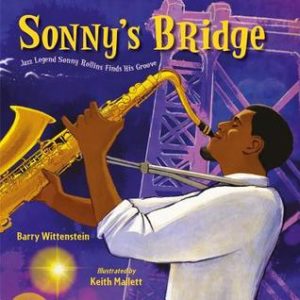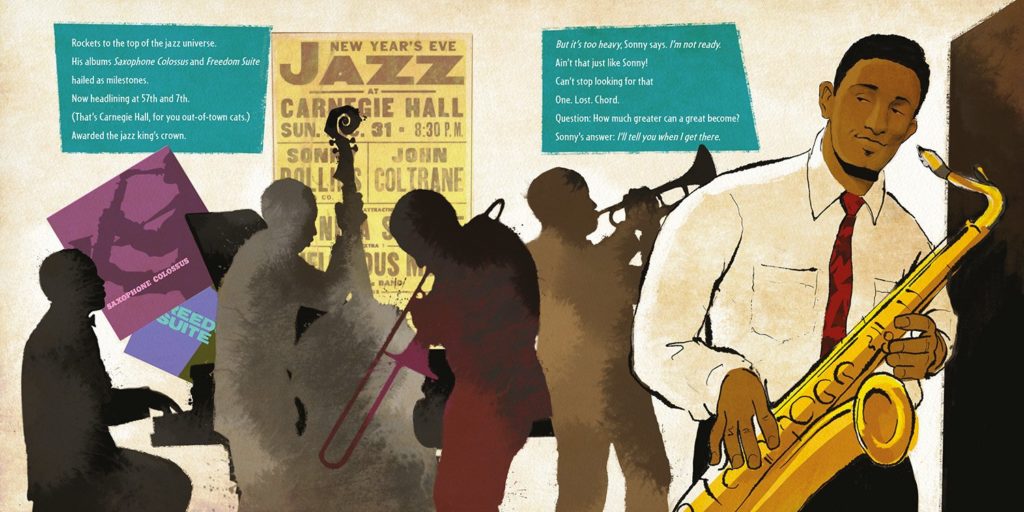Sonny’s Bridge: Jazz Legend Sonny Rollins Finds His Groove
Author: Barry Wittenstein
Illustrator: Keith Mallett
Published May 21st, 2019 by Charlesbridge Publishing
Summary: This groovy, bebopping picture book biography chronicles the legendary jazz saxophonist Sonny Rollins’s search for inspiration on the Williamsburg Bridge after quitting the jazz scene in 1959.
Rollins is one of the most prolific sax players in the history of jazz, but, in 1959, at the height of his career, he vanished from the jazz scene. His return to music was an interesting journey–with a long detour on the Williamsburg Bridge. Too loud to practice in his apartment, Rollins played on the New York City landmark for two years among the cacophony of traffic and the stares of bystanders, leading to the release of his album, The Bridge.
Written in rhythmic prose with a bebop edge, this picture-book biography of Sonny Rollins’s journey to get his groove back will delight young and old fans alike.
About the Author: Barry Wittenstein has worked at CBS Records, CBS News, and was a web editor and writer for Major League Baseball. He is now a New York City elementary-school substitute teacher and children’s author. He is the author of The Boo-Boos That Changed the World: The True Story About an Accidental Invention (Really!) and Waiting for Pumpsie. Barry lives in the Bronx.
About the Illustrator: Keith Mallett studied art at Hunter College in New York City. Keith’s work was commissioned to celebrate the 50th anniversary of Jackie Robinson’s historic breakthrough into major league baseball, has graced the cover of Chicken Soup for the African American Soul, and has been featured in many movies and TV shows. He is the illustrator of Take a Picture of Me, James VanDerZee and How Jelly Roll Morton Invented Jazz. Keith lives in San Diego, California.
Praise: “An appropriately jazzy picture-book biography of African-American musician Sonny Rollins. It impresses from the endpapers, which mirror a vinyl LP in its paper sleeve and then playing on a turntable, to the liner notes about Rollins’ seminal album “The Bridge” in the back.” -Kirkus Reviews, starred review
“The life of jazz legend Sonny Rollins pulses with the rousing spontaneity of his music in Wittenstein’s free verse biography. Readers witness Rollins’s career as an acclaimed musician followed by his explosive success and the subsequent reincarnations of his art.” -School Library Journal, starred review
Review: The rhythm of the writing in Sonny’s Bridge automatically gets you toe tapping while reading. It captures the feeling and flow of jazz which truly sets the stage for Sonny’s story because in the end this is the story of Sonny Rollins and his path to finding his musical voice.
In addition to the rhythm in the writing, the illustrators images bring the words to life using movement, color, and line to show the power of the music.
Together, the words and music bring Sonny’s story to the readers in a way that will illuminate his struggles and his triumphs.
Teachers’ Tools for Navigation: Because of the rhythmic writing, this will be an amazing read aloud! And then the students can listen to The Bridge.
We are lucky to be living in a time with so many wonderful biographies out there about amazing people and a lot of them happen to be musicians, so what a great opportunity for book clubs or jig saws to look at different musicians and how they became who they are/were and how they changed not only musical history but sometimes even history.
Discussion Questions:
- Why does Sonny find the bridge to be the best place for him to practice?
- Why did Sonny take off two years and how did it change his life?
- How did Sonny’s life correspond with Black Americans’ fight for equal rights?
- How did the illustrator show Sonny’s music through is artwork?
- Why would some want the bridge to be renamed Sonny’s Bridge?
- After listening to The Bridge, how did the author capture the feeling of jazz in his writing?
Creator Corner with Barry Wittenstein from KidLitTV:
Flagged Passages:
Read This If You Love: Music (specifically jazz), Jazz Day by Roxane Orgill, Trombone Shorty by Troy Andrews, Little Melba and her Big Trombone by Katheryn Russell-Brown, Ella Fitzgerald by Andrea Davis Pinkney, Duke Ellington by Andrea Davis Pinkney, Hip Hop Lollipop by Susan Montanari, The 5 O’Clock Band by Troy Andrews, Born to Swing by Mara Rockliff, Muddy by Michael James Mahin, Stand Up and Sing by Suanna Reich
Recommended For:
**Thank you to Charlesbridge Publishing for providing a copy for review**






